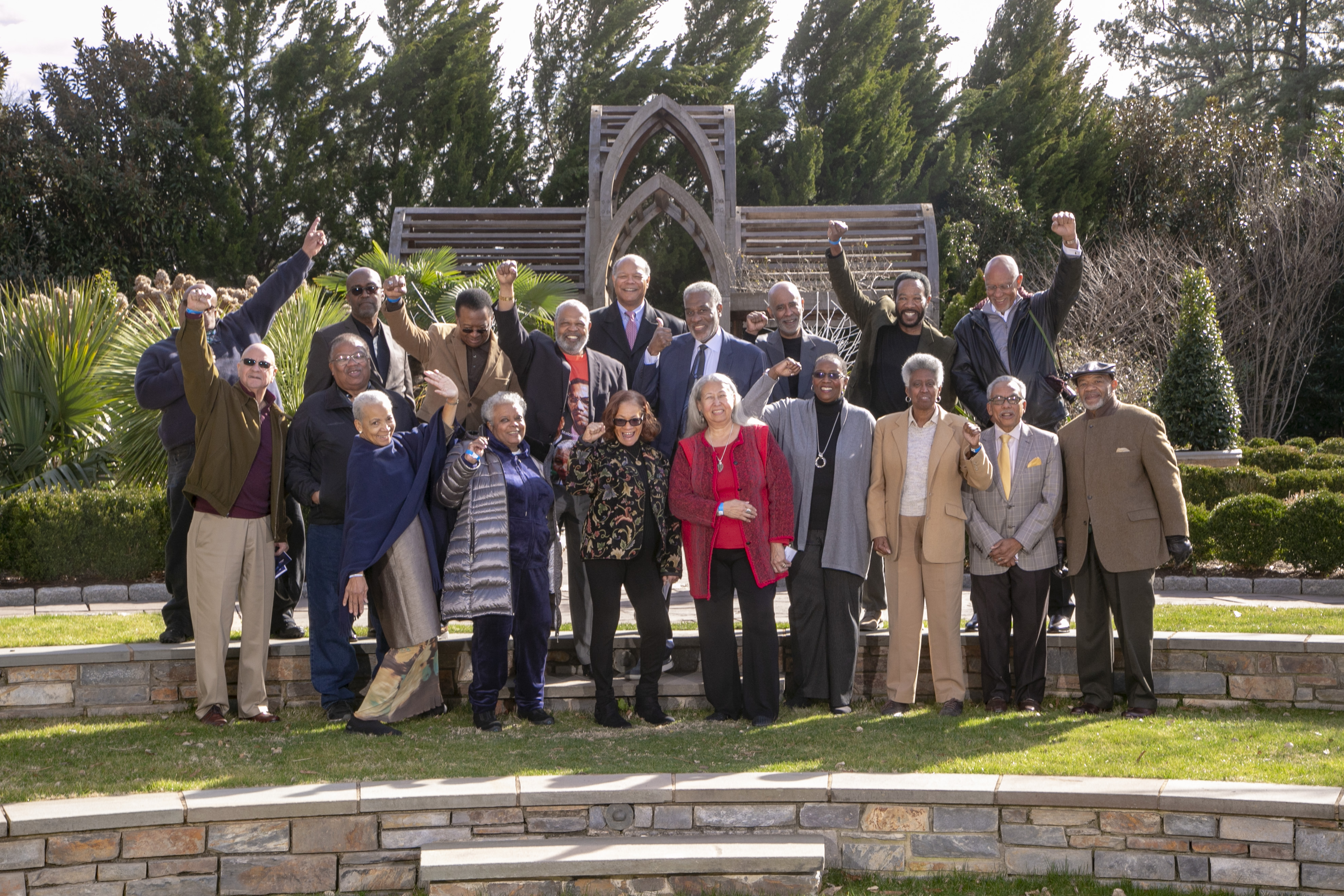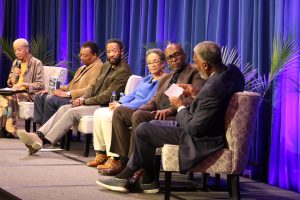Nearly two dozen of the protesters met with administrators then told their stories to a sold-out audience

The 1969 Allen Building Takeover has loomed large in Duke’s history. This past weekend, Feb. 9-10, nearly two dozen of the Duke alums who protested returned to campus to check on the status of the demands they issued 50 years ago and to see the impact of their activism.
The sold-out event, “Commemorating the Allen Building Takeover: Fifty Years Later,” was hosted by the Department of African & African American Studies (AAAS) and held in the Ambassador Ballroom at the Washington Duke Inn. Two panel discussions, “The Original Protesters Tell Their Stories,” and “Activism Then and Now: An Intergenerational Discussion,” were followed by a reception at the Nasher Museum of Art. Hundreds attended and watched via livestream.
On Saturday morning, the black Duke alumni who participated in the Allen Building Takeover were invited to a private brunch with President Vincent Price. Price acknowledged their role in challenging Duke to become more inclusive and diverse.
“In the action that you took, you forever shifted our sails towards the prevailing winds of justice and equality,” Price said.

“I don’t quite know how to say thank you enough for what you did 50 years ago,” Valerie Ashby, dean of Trinity College of Arts & Sciences, told the alum in her introductory remarks during Saturday’s main program, adding that her role on campus would not exist had it not been for the takeover.
“So something happens differently for me when I walk in the Allen Building,” she said, describing the portrait of Julian Abele, the black architect who designed Duke’s campus. “Then I go into my office … which is right outside of where you did your work, I am not confused about how I am able to walk into that office each day. I owe you a huge debt of gratitude. Our job is to make you proud. Our job is to continue to help the university move forward so nothing that you did would have been done in vain.”
Ashby joined Mark Anthony Neal, chair of AAAS, and Qsanet Tekie, ’19, president of the Duke Eritrean and Ethiopian Student Transnational Association, to welcome “the Originals” and provide historical context for their activism 50 years ago. On Sunday, the Duke alumni had an informal Sunday service with remarks by Rev. Bill Turner, ’71, and previewed an exhibit on the takeover in Perkins Library.
Many of “the Originals” had attended rural, segregated schools. They had been hand-picked by their communities — as national merit scholars and academically gifted — to attend Duke not long after the university integrated in 1963.
The impetus for the Takeover came when fall semester grades were released.
“I had black people coming up to me who had never come to any meetings or who had never spoken to me, come to me and said, ‘Chuck we have to do something, these grades are not fair.’ They had stories of [the racism] they had experienced in class,” said Chuck Hopkins, ’69, co-founder of the Afro-American Society.
On Feb. 13, 1969, Hopkins and dozens of other black Duke students barricaded themselves inside of the Allen Building, presenting the university administration with a list of demands, an action that has become a model for student activism on campus over the years.
The takeover resulted in the hiring of more black faculty, the creation of a black studies program which would eventually become AAAS, and a black student union that is now the Mary Lou Williams Center for Black Culture.
All agreed it took courage and commitment to go into the building.
“I was concerned we might die, especially if we brought guns,” Michael McBride, ’71, said. At other colleges and universities, students were being shot and killed for protesting.
“One of the things we strategized in our meetings was that we weren’t going to bring arms or touch anyone. Our whole thing was let’s not give the administration a reason to focus on something else,” Hopkins said.
“Once we decided to do that I called Mark Pinsky, ’69, at the (Duke) Chronicle to make sure the national press would cover it. We didn’t want to be an isolated event down here in Durham,” he said. “Howard (Fuller) came later in the day.”

Fuller, who at the time of the takeover was a local community activist in Durham, mentored the Duke students and later became co-founder of Malcolm X Liberation University, where some of them enrolled after leaving Duke that spring.
In the aftermath, the students were put on probation, some were arrested, and some left Duke altogether, never to return.
“We figured the university would not suspend all black students. As part of our trial strategy, we had them sign a document saying they had gone into the building, even when they hadn’t,” Becton, JD ’69, said. “It was not just the students, but the future of Duke that was on trial.”
“It’s easy to talk about now, but it wasn’t easy on that day. We could have been killed. That is not a statement in the abstract,” Fuller said. “When we went into that building in 1969, we were extending the lines of hope and organization. We took our people’s history and suffering into that building.”
VIEW COVERAGE INCLUDING PHOTOS HERE




